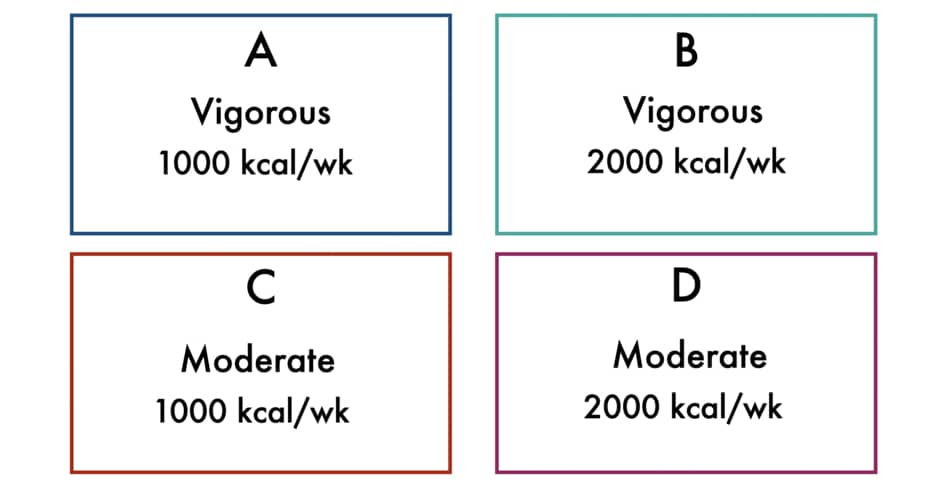I’ve noticed a big discrepancy between the peloton rides’ duration and the rest of their content. In this article I will clarify why are peloton classes so short and what can you do to add more training volume.
As a whole, most of the peloton strength, cardio, and stretch classes are so short because doing 45 to 60-minute daily workouts would be unrealistic for most people. Plus, studies have shown that 20 to 30-minute exercise session improves cognition, whereas longer durations have negligible benefits.
This means you can get similar results from doing shorter workouts (more on that later).

Peloton Class Length and Weight Loss
Choosing longer peloton classes doesn’t always guarantee that you will get better results. Here’s what I mean by that.
Dr. John Jakicic from the University of Pittsburgh documented 201 sedentary women and divided them into 4 groups.
All of the groups were instructed to perform exercises 5 days per week. The only difference between the groups was the intensity of the workouts and class duration.
- The moderate duration was classified as a workout that takes 20 to 25 minutes (which was estimated to burn around 1000 calories per week).
- The longer duration was described as 40 to 45 minutes sessions (with approximately 2000 calorie expenditure per week).
See the graph below.

After 12 months, the results have shown that despite doing longer duration exercise, all of the groups had similar outcomes.
See the table below.
| Groups | Avg min per week | Avg weight loss |
|---|---|---|
| A | 142.5 | 7.0 kg |
| B | 189.6 | 8.8 kg |
| C | 147.7 | 7.1 kg |
| D | 189.3 | 8.2 kg |
On the surface, it may seem like group B got the best results.
However, please keep in mind that these were the results after 12 months of exercise and the biggest difference was 1.8 kg.
That’s less than 4 lbs.
Dr. Jakicic concluded that “significant weight loss and improved cardiorespiratory fitness were achieved through the combination of exercise and diet, although no differences were found based on different exercise durations and intensities” (Jakicic et al. 2003).
This means that doing short and less intense peloton classes can be as effective as doing long and vigorous workouts.
Are Short Peloton Classes Effective?
In general, the short peloton classes are effective, as long as they’re done with moderate intensity.
Shorter workouts have more achievable thanks to the dose-response concept that elicits training adaptations as well as reduces the risk of overtraining.
The dose-response concept, also known as the hormesis effect, is been known since the 8th century and it describes moderation and harmony.
It works by lowering the dose of stimuli (e.g. exercise) to achieve maximum benefits.
By choosing short peloton classes you not only can increase your workout adherence (and enjoyment), but also you make sure you’re not going over the board with the training volume.
That is actually one of the reasons why I love short peloton workouts.
I don’t train to get abs. I train to boost my cognitive performance. I use exercise as a way to be more productive and focused throughout the day.
Studies have shown that “moderate exercise intensity for 20 min as recommended by the ACSM, results in the largest benefits to cognitive performance, compared to 10 or 45 minutes” (Chang et al. 2015).
This means if you train to improve your well-being, lower anxiety, and have more energy for the day, it is much better to do small and often.
Why Are Peloton Classes So Short?
The majority of the peloton classes are short because for many people short bouts of exercise training may fit better into a busy schedule than a single long bout. Also, short workouts are more achievable for beginners and untrained individuals.
Some of the peloton classes like stretch, cardio, and strength are dominated by 5 to 15-minute sessions.
Have a look at the table below.
| Peloton class | Most popular class duration |
|---|---|
| Strength | 10 minute |
| Cardio | 20 minute |
| Stretch | 5 minute |
| Cycling | 30 minute |
| Walking | 20 minute |
As you can see, the most popular peloton workouts aren’t the ones that are the longest or toughest. In fact, it’s the opposite.
Also, most of the peloton live classes are within 10 to 20 minutes duration.
People who are busy with work, family, house, traveling, and commuting may find it challenging to budget an additional 45 to 60 minutes per day to train.
On the other hand, doing a 15 or 20-minute class is low-hanging fruit, which is more realistic and manageable, especially at the beginning of the fitness journey.
Maybe Peloton classes are too short?
People who are already trained and have more time on their hands may find that most of the peloton classes are too short.
In that case, the only way to make the workouts more challenging and stimulating is to stack workouts one after another.
This helps you not only to spend more time doing things you love but also gives you more variety because you can mix different fitness genres within one long workout.
Stacking classes allows you to choose and transition from one session to another automatically. It works by pre-selecting several workouts that you want to do and choosing the preferable order by which you want to train.
This means you can assemble your favorite workouts into one workout that includes several different class categories.
Conclusion
As you can see, the vast majority of peloton classes (not including the rides) are between 10 to 20 minutes.
That’s because doing shorter workouts is more achievable and less strenuous on the body, while equally effective as 45 to 60-minute workouts.
This means you can easily do your workouts every day, without worrying about overtraining. And once you feel ready for longer sessions, you can always stack multiple classes back to back.
